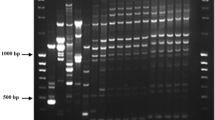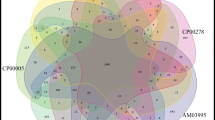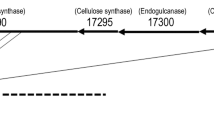Abstract
Colletotrichum gloeosporioides is the common causal agent of anthracnose in papaya (Carica papaya L.) fruits, and infection by this fungal pathogen results in severe post-harvest losses. In the Yucatán peninsula (Mexico) a different Colletotrichum species was isolated from papaya fruits with atypical anthracnose lesions. The DNAs from a variety of Colletotrichum isolates producing typical and atypical lesions, respectively, were amplified by PCR with C.gloeosporioides-specific primers. All isolates from typical anthracnose lesions yielded a 450 bp PCR product, but DNAs from isolates with atypical lesions failed to produce an amplification product. For further characterization, the rDNA 5.8S-ITS region was amplified by PCR and processed for sequencing and RFLP analysis, respectively, to verify the identity of the papaya anthracnose pathogens. The results revealed unequivocally the existence of two Colletotrichum species causing anthracnose lesions on papaya fruits: C. gloeosporioides and C. capsici. PCR-RFLP using the restriction endonuclease MspI reliably reproduced restriction patterns specific for C. capsici or C. gloeosporioides. The generation of RFLP patterns by MspI (or AluI or RsaI) is a rapid, accurate, and unequivocal method for the detection and differentiation of these two Colletotrichum species.



Similar content being viewed by others
References
Freeman, S. (2000). Genetic diversity and host specificity of Colletotrichum species on various fruits. In D. Prousky, S. Freeman, & M. B. Dickman (Eds.), Colletotrichum. Host specificity, pathology and host-pathogen interaction. (pp. 131–144). St Paul Minnesota USA: APS Press.
Smith, B. J., & Black, L. L. (1990). Morphological, cultural and pathogenic variation among Colletotrichum species isolated from strawberry. Plant Disease, 74, 69–76. doi:10.1094/PD-74-0069.
Brown, A. E., Sreenivasaprasad, S., & Timmer, L. W. (1996). Molecular characterization of slow-growing-orange and key lime anthracnose strains of Colletotrichum from citrus as C. acutatum. Phytopathology, 86, 523–527. doi:10.1094/Phyto-86-523.
Freeman, S., Katan, T., & Shabi, E. (1998). Characterization of Colletotrichum species responsible for anthracnose diseases of various fruits. Plant Disease, 82, 596–605. doi:10.1094/PDIS.1998.82.6.596.
Peres, N. A. R., Kuramae, E. E., Dias, M. S. C., & de Sousa, N. L. (2002). Identification and characterization of Colletotrichum spp affecting fruit after harvest in Brazil. Journal of Phytopathology, 150, 128–134. doi:10.1046/j.1439-0434.2002.00732.x.
McDonald, B. A., & Mc Dermott, J. M. (1993). Population genetics of plant pathogenic fungi. Bioscience, 43, 311–319. doi:10.2307/1312063.
Samuels, G. J., & Siefert, K. A. (1995). The impact of molecular characteristics on systematics of filamentous ascomycetes. Annual Review of Phytopathology, 33, 37–67. doi:10.1146/annurev.py.33.090195.000345.
Frederick, R. D., Snyder, C. L., Peterson, G. L., & Bonde, M. R. (2002). Polymerase chain reaction assays for the detection and discrimination of the soybean rust pathogens Phakopsora pachyrhizi and Phakopsora meibomiae. Phytopathology, 92, 217–227. doi:10.1094/PHYTO.2002.92.2.217.
Saha, T., Kumar, A., Ravindran, M., Jacob, C. K., Roy, B., & Nazeer, M. A. (2002). Identification of Colletotrichum acutatum from rubber using random amplified polymorphic DNAs and ribosomal DNA polymorphisms. Mycological Research, 106, 215–221. doi:10.1017/S0953756201005342.
Talhinhas, P., Sreenivasaprasad, S., Neves-Martin, J., & Oliveira, H. (2002). Genetic and morphological characterization of Colletotrichum acutatum causing anthracnose of lupins. Phytopathology, 92, 986–996. doi:10.1094/PHYTO.2002.92.9.986.
Gonzalez-Chavira, M. M., Cardenas-Soriano, E., Nieto-Angel, D., Guevara-Gonzalez, R. G., Cruz-Hernandez, A., & Casarrubias-Carrillo, U. (2003). Genetic variability of Colletotrichum gloeosporioides (Penz.) Penz and Sacc. isolated from papaya (Carica papaya L.) fruits using RAPD molecular markers. Revista Mexicana de Fitopatologia, 21, 338–345.
Cia, P., Pascholati, S. F., Benato, E. A., Camili, E. C., & Dantos, C. A. (2007). Effects of gamma and UV-C irradiation on the post harvest control of papaya anthracnose. Postharvest Biology and Technology, 43, 366–373. doi:10.1016/j.postharvbio.2006.10.004.
Tapia-Tussell, R., Lappe, P., Ulloa, M., Quijano-Ramayo, A., Cáceres-Farfán, M., Larque-Saavedra, A., et al. (2006). A rapid and simple method for DNA extraction from yeast and fungi isolated from Agave fourcroydes. Molecular Biotechnology, 33, 67–70.
Mills, P. R., Sreenivasaprasad, S., & Brown, A. E. (1992). Detection and differentiation of Colletotrichum gloeosporioides isolates using PCR. FEMS Microbiology Letters, 98, 137–144. doi:10.1111/j.1574-6968.1992.tb05503.x.
White, T. J., Bruns, T., Lee, S., & Taylor, J. (1990). Amplification and direct sequencing of fungal ribosomal RNA genes for phylogenetics. In M. Innis, D. Gelfand, J. Sninsky, & T. White (Eds.), PCR protocols, a guide to methods and applications (pp. 315–322). San Diego CA USA: Academic Press.
Naumova, E. S., Sukhotina, N. N., & Naumov, G. I. (2004). Molecular-genetic differentiation of the dairy yeast Kluyveromyces lactis and its closest wild relatives. FEMS Yeast Res, 5, 263–269. doi:10.1016/j.femsyr.2004.08.006.
Hall, T. (2005). BioEdit v 7.0.5. http://www.mbio.ncsu.edu/BioEdit/.
Chen, L. S., Chu, C., Liu, C. D., Chen, R. S., & Tsay, J. G. (2006). PCR-based detection and differentiation of anthracnose pathogens, Colletotrichum gloeosporioides and C. truncatum, from vegetable soybean in Taiwan. Journal of Phytopathology, 154, 654–662. doi:10.1111/j.1439-0434.2006.01163.x.
Bardas, G. A., Koutita, O., & Tzavella-Klonari, K. (2007). Geographical distribution, pathotype characterization, and molecular diversity of Colletotrichum lindemuthianum in Greece and resistance of Greek bean cultivars. Plant Disease, 91, 1379–1385. doi:10.1094/PDIS-91-11-1379.
Voorrips, R. E., Finkers, R., Sanjaya, L., & Groenwold, R. (2004). QTL mapping of anthracnose (Colletotrichum spp) resistance in a cross between Capsicum annuum and C chinense. Theoretical and Applied Genetics, 109, 1275–1282. doi:10.1007/s00122-004-1738-1.
Sharma, P. N., Kaur, M., Sharma, O. P., Sharma, P., & Pathania, A. (2005). Morphological, pathological and molecular variability in Colletotrichum capsici, the cause of fruits rot of chillies in the subtropical region of north-western India. Journal of Phytopathology, 153, 232–237. doi:10.1111/j.1439-0434.2005.00959.x.
Than, P. P., Jeewon, R., Hyde, K. D., Pongsupasamit, S., Mongkolporn, O., Taylor, P. W. J. (2008). Characterization and pathogenicity of Colletotrichum species associated with anthracnose on chilli (Capsicum spp) in Thailand. Plant Pathology. doi: 10.1111/j.1365-3059.2007.01782.x.
Pring, R. J., Nash, C., Zakaria, M., & Bailey, J. A. (1995). Infection process and host range of Colletotrichum capsici. Physiological and Molecular Plant Pathology, 46, 137–152. doi:10.1006/pmpp. 1995.1011.
Martinez-Culebras, P. V., Barrio, E., Garcia, M. D., & Querol, A. (2000). Identification of Colletotrichum species responsible for anthracnose of strawberry based on the internal transcribed spacers of the ribosomal region. FEMS Microbiology Letters, 189, 97–101.
Abang, M. M., Winter, S., Green, K. R., Hoffmann, P., Mignouna, H. D., & Wolf, G. A. (2002). Molecular identification of Colletotrichum gloeosporioides causing yam anthracnose in Nigeria. Plant Pathology, 51, 63–71. doi:10.1046/j.0032-0862.2001.00655.x.
Acknowledgements
The authors are grateful to Dr. Jairo Alejo for providing some of the samples of papaya fruits with anthracnose used in this study; and especially to Prof. Dr. Wolfgang Rohde, from Max Planck Institute for Plant Breeding Research, for his complete review of this manuscript and his time and effort in providing comments.
Author information
Authors and Affiliations
Corresponding author
Rights and permissions
About this article
Cite this article
Tapia-Tussell, R., Quijano-Ramayo, A., Cortes-Velazquez, A. et al. PCR-Based Detection and Characterization of the Fungal Pathogens Colletotrichum gloeosporioides and Colletotrichum capsici Causing Anthracnose in Papaya (Carica papaya L.) in the Yucatan Peninsula. Mol Biotechnol 40, 293–298 (2008). https://doi.org/10.1007/s12033-008-9093-0
Received:
Accepted:
Published:
Issue Date:
DOI: https://doi.org/10.1007/s12033-008-9093-0




